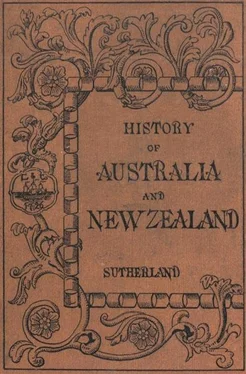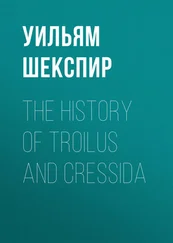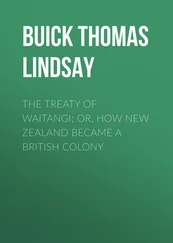2. Governor Denison.—Governor Fitzroy, who had been appointed in 1847, remained eight years in office, and thus was present during the events which made so great a change in the prospects of the colonies. In 1855 he returned to England, and his place was taken by Sir William Denison, who had previously been Governor of Tasmania. In 1854 great excitement had been caused in Sydney by the outbreak of the Crimean War, and the people, in their fear lest they might suddenly receive an unwelcome visit from Russian cruisers, hastened to complete a system of fortifications for the harbour. The new Governor, who had in youth been trained as an officer of the Royal Engineers in England, took a warm interest in the operations. He built a small fortress on an islet in the middle of the harbour, and placed batteries of guns at suitable spots along the shores. The advance of the science of warfare in recent times has left these little fortifications but sorry defences against modern ironclads; but they have since been replaced by some of those improvements in defence which have accompanied the invention of new methods of attack.
3. Constitutional Changes.—The Constitutions which had been framed for the colonies by the Imperial Parliament in 1850 were not expected to be more than temporary. The British Government had wisely determined to allow each of the colonies to frame for itself the Constitution which it deemed most suitable to its requirements, and had instructed the Legislative Councils which were elected in 1851 to report as to the wishes of their respective colonies. In Sydney the Council entrusted the framing of the new Constitution to a committee, which decided to adopt the English system of government by two Houses—the one to represent the people as a whole, the other to watch over the interests of those who, by their superior wealth, might be supposed to have more than an ordinary stake in the welfare of the country. It was very quickly arranged that the popular House should consist of not less than fifty-four members, to be elected by men who paid a small rental, or possessed property of a certain annual value. But with regard to the nature of the Upper House, it was much more difficult to come to a decision. Wentworth proposed that the Queen should establish a colonial peerage to form a small House of Lords, holding their seats by hereditary right; but this idea raised so great an outcry that he made haste to abandon it. Several of the committee were in favour of the scheme, afterwards adopted in Victoria, of making the Upper House elective, while limiting the choice of members to those who possessed at least £5,000 worth of real property. After much discussion, however, it was decided to give to the Governor the power of nominating the members of this chamber, which was to consist of not less than twenty-one persons.
The Legislative Council adopted this scheme, and sent it to England for the assent of the Queen; they also requested that their Constitution might be still further assimilated to that of Great Britain by the introduction of responsible government, so that the Ministers who controlled the affairs of the colony should be no longer officials appointed or dismissed by the Governor and Secretary of State, but should, in future, be chosen by the Parliament to advise the Governor on all matters of public interest, and should be liable to dismissal from office so soon as the Parliament lost confidence in their ability or prudence. The British Government at once gave its assent to this Constitution, which was accordingly inaugurated in 1856; and from that date the political management of New South Wales has been an imitation of that of the British Empire. In 1858 two small modifications were introduced: the Lower House was increased in numbers to sixty-eight members, and the privilege of voting for it was extended to every male person over twenty-one years of age who had dwelt not less than six months in the colony.
4. Floods and Droughts.—From the very commencement of its existence, New South Wales has been subject to the two extremes of heavy floods and dreary periods of drought. The mountains are so near to the coast that the rivers have but short courses, and the descent is so steep that, during rainy seasons, the rush of waters deluges the plains near the sea, causing floods of fatal suddenness. At the same time, the waters are carried off so rapidly that there are no supplies of moisture left to serve for those seasons in which but little rain falls. The districts along the banks of the Hunter, Hawkesbury, and Shoalhaven Rivers have been especially liable to destructive inundations; and, from time to time, the people of Sydney have been obliged to send up lifeboats for the purpose of releasing the unfortunate settlers from the roofs and chimneys of their houses, where they have been forced to seek refuge from the rising waters. The Murrumbidgee also used occasionally to spread out into a great sea, carrying off houses and crops, cattle, and, oftentimes, the people themselves. In 1852 a flood of this description completely destroyed the town of Gundagai, and no less than eighty persons perished, either from drowning or from being exposed to the storm as they clung to the branches of trees.
5. The Dunbar.—A great gloom was cast over the colony in 1857 by the loss of a fine ship within seven miles of the centre of Sydney. The Dunbar sailed from Plymouth in that year with about a hundred and twenty people on board, many of them well-known colonists who had visited England, and were now on their way homewards. As the vessel approached the coast, a heavy gale came down from the north-east, and, ere they could reach the entrance to Port Jackson, night had closed around them. In the deep and stormy gloom they beat to and fro for some time, but at length the captain thought it safer to make for Sydney Heads than to toss about on so wild a sea. He brought the vessel close in to the shore in order to search for the entrance, and when against the stormy sky he perceived a break in the black cliff’s he steered for the opening. This, however, was not the entrance, but only a hollow in the cliffs, called by the Sydney people the “Gap”. The vessel was standing straight in for the rocks, when a mass of boiling surf was observed in the place where they thought the opening was, and ere she could be put about she crashed violently upon the foot of a cliff that frowned ninety feet above; there was a shriek, and then the surf rolled back the fragments and the drowning men. At daybreak the word was given that a ship had been wrecked at the Gap, and during the day thousands of people poured forth from Sydney to view the scene of the disaster. On the following morning it was discovered that there was a solitary survivor, who, having been washed into a hollow in the face of the rock, lay concealed in his place of refuge throughout that dreadful night and all the succeeding day. A young man was found who volunteered to let himself down by a rope and rescue the half-dead seaman.
To prevent the repetition of so sad an occurrence, lighthouses were erected for the guidance of ship captains entering the harbour.
In 1852 the people of Sydney had the satisfaction of inaugurating the first Australian University—a structure whose noble front, magnificent halls, and splendid appointments for the furtherance of science will always do credit to the liberality and high aspirations of the colony. In 1857 the “Australian Museum” was opened, and formed the nucleus of the present excellent collection of specimens. During this period several newspapers sprang into existence, railways began to stretch out from the metropolis, and lines of telegraph united Sydney with the leading cities of the other colonies. In August, 1853, the first mail steamer from England, named the Chusan , arrived in Port Jackson, and helped to make the settlers of Australia feel less exiled, as they now could have regular news of their friends and of European events little more than two months old.
Читать дальше












